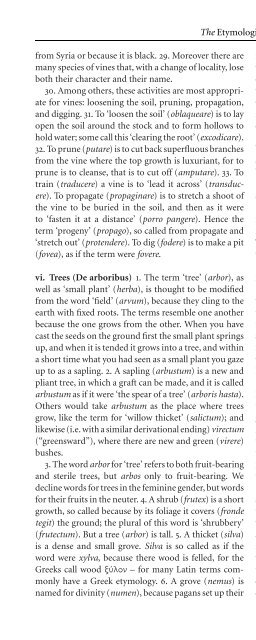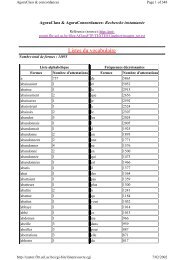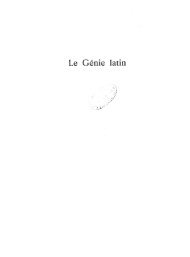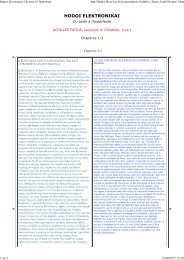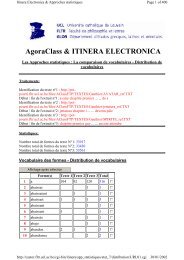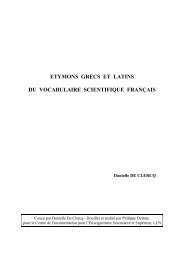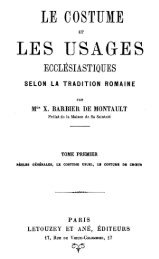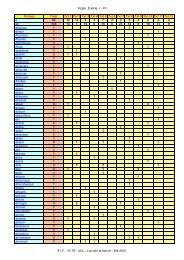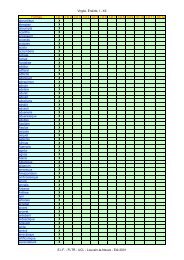The Etymologies of Isidore of Seville - Pot-pourri
The Etymologies of Isidore of Seville - Pot-pourri
The Etymologies of Isidore of Seville - Pot-pourri
You also want an ePaper? Increase the reach of your titles
YUMPU automatically turns print PDFs into web optimized ePapers that Google loves.
from Syria or because itisblack.29.Moreoverthere are<br />
many species <strong>of</strong> vines that, with a change <strong>of</strong> locality, lose<br />
both their character and their name.<br />
30.Among others, these activities are most appropriate<br />
for vines: loosening the soil, pruning, propagation,<br />
and digging. 31.To‘loosen the soil’ (oblaqueare)istolay<br />
open the soil around the stock and to form hollows to<br />
hold water; some call this ‘clearing the root’ (excodicare).<br />
32.Toprune(putare)istocut back superfluous branches<br />
from the vine where the top growth is luxuriant, for to<br />
prune is to cleanse, that is to cut <strong>of</strong>f (amputare). 33. To<br />
train (traducere) avineis to ‘lead it across’ (transducere).<br />
To propagate (propaginare) istostretchashoot<strong>of</strong><br />
the vine to beburiedinthesoil,andthenasitwere<br />
to ‘fasten it at a distance’ (porro pangere). Hence the<br />
term ‘progeny’ (propago), so called from propagate and<br />
‘stretch out’ (protendere). To dig (fodere)istomakeapit<br />
(fovea), as if the term were fovere.<br />
vi. Trees (De arboribus) 1. <strong>The</strong>term‘tree’ (arbor), as<br />
well as ‘small plant’ (herba), is thought to be modified<br />
from the word ‘field’ (arvum), because they cling to the<br />
earth with fixed roots. <strong>The</strong> terms resemble one another<br />
because the one grows from the other. When you have<br />
cast the seeds on the ground first the small plant springs<br />
up, and when it is tended it grows into a tree, and within<br />
a short time what you had seen as a small plant you gaze<br />
up to as a sapling. 2. Asapling (arbustum) isanewand<br />
pliant tree, in which a graft can be made, and it is called<br />
arbustum as if it were ‘the spear <strong>of</strong> a tree’ (arboris hasta).<br />
Others would take arbustum as the place where trees<br />
grow, like the term for ‘willow thicket’ (salictum); and<br />
likewise (i.e. with a similar derivational ending) virectum<br />
(“greensward”), where there are new and green (virere)<br />
bushes.<br />
3.<strong>The</strong>wordarbor for ‘tree’ refers to both fruit-bearing<br />
and sterile trees, but arbos only to fruit-bearing. We<br />
decline words for trees in the feminine gender, but words<br />
for their fruits in the neuter. 4.Ashrub (frutex)isashort<br />
growth, so called because by its foliage it covers (fronde<br />
tegit) the ground; the plural <strong>of</strong> this word is ‘shrubbery’<br />
(frutectum). But atree(arbor) istall. 5. Athicket(silva)<br />
is a dense and small grove. Silva is so called as if the<br />
word were xylva, because there wood is felled, for the<br />
Greeks call wood –formany Latin terms commonly<br />
have a Greek etymology. 6. Agrove(nemus) is<br />
named for divinity (numen), because pagans set up their<br />
<strong>The</strong> <strong>Etymologies</strong> XVII.v.29–vi.18 341<br />
idols there, for groves are sites with larger trees, shady<br />
with foliage. 7.A‘sacredgrove’(lucus)isadense thicket<br />
<strong>of</strong> trees that lets no light come to the ground, named by<br />
way <strong>of</strong> antiphrasis because it ‘sheds no light’ (non lucere).<br />
Or it is named from ‘light’ (lux, gen.lucis) becausein<br />
it torches or candles used to give <strong>of</strong>f light against the<br />
darkness <strong>of</strong> the grove.<br />
8. Aglade(saltus) isahighthicket<strong>of</strong>trees,called<br />
by this name because it ‘springs up’ (exsilire) onhigh<br />
and rises al<strong>of</strong>t. 9. Anaviaria is a hidden grove so called<br />
because it is the haunt <strong>of</strong> birds (avis). 10.‘Secondgrowth’<br />
(recidivum)with regard to trees consists <strong>of</strong> what sprouts<br />
again after other parts have been cut. Some say that<br />
recidivum is from ‘falling’ (cadere), because they make<br />
new growth after being felled. Others have said that it<br />
is from ‘cutting back’ (recidere) and sprouting again.<br />
<strong>The</strong>refore something may be recidivus (i.e. “restored”)<br />
where there has been death or falling.<br />
11.Wespeak <strong>of</strong> grafting (insitio)when, after the stem<br />
is split, a scion from a fertile tree is grafted (inserere,ppl.<br />
insitus)onto a sterile tree; or, it is the implanting <strong>of</strong> buds<br />
when, after the bark is sliced open, the bud <strong>of</strong> a foreign<br />
tree is set into theinner bark. 12. Cuttings(planta) are<br />
from trees, but seedlings (plantaria)aregrownfromseed<br />
and are transplanted with their roots from their original<br />
soil. 13. Turf(caespes) isalowgrowth, as if the term<br />
were ‘spears’ (cuspis) or‘around the feet’ (circa pedes).<br />
Branches (frons) are so called because they ‘produce’<br />
(ferre) shoots or shade, for they are the cause <strong>of</strong> shade.<br />
Eyes (oculus) arethenodes from which branches grow.<br />
14. <strong>The</strong>root (radix) issocalled because fixed in the<br />
ground in the manner <strong>of</strong> ‘radiating spokes’ (radius), as<br />
it were, it goes down deep, for natural philosophers say<br />
that the depth <strong>of</strong> the roots is equal to the height <strong>of</strong> the<br />
trees. Others say roots are named for their similarity to<br />
rays (radius), or because, if they are cut away (eradere),<br />
they do not grow back.<br />
15. <strong>The</strong>trunk (truncus) isthestandingpart<strong>of</strong>atree,<br />
and it rests on the root. <strong>The</strong> ancients called bark (cortex)<br />
the corux; itisnamedcortex because it covers the wood<br />
withaskin(corium). 16. Liber is the inner part <strong>of</strong> the bark,<br />
so called from the bark’s being ‘released’ (liberare), that<br />
is, set apart, for it is a kind <strong>of</strong> medium between bark and<br />
wood. 17. Branches (ramus) arewhat extend from the<br />
trunk, just as from little branches (ramusculus)yetothers<br />
grow. Shoots (serculus)are so named because they are<br />
cut with asaw(serra). 18. Asucker (virgultum) iswhat


